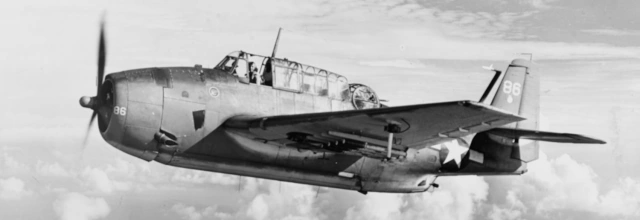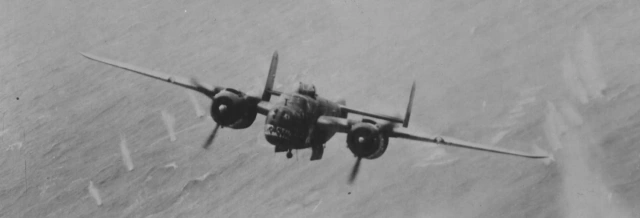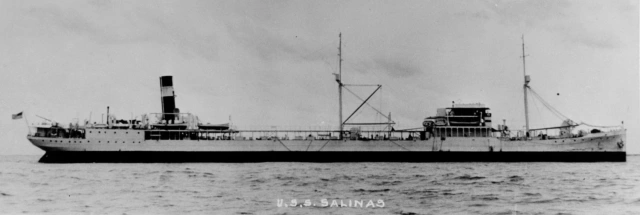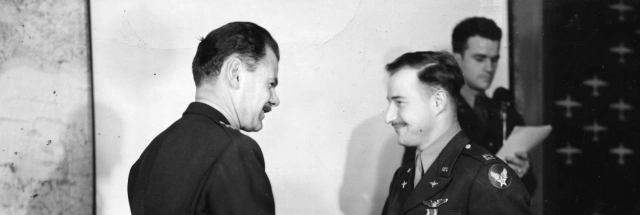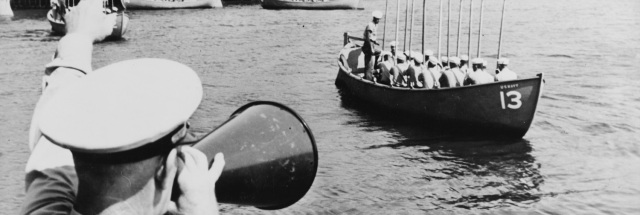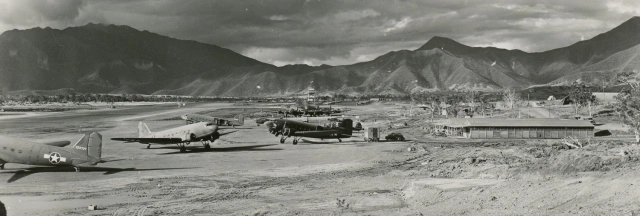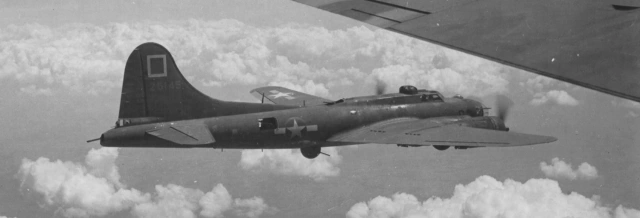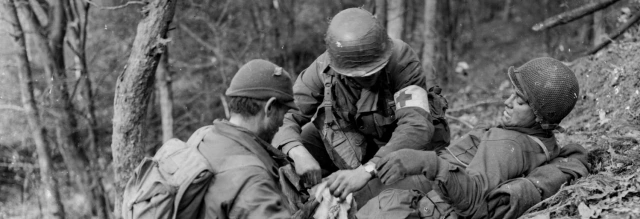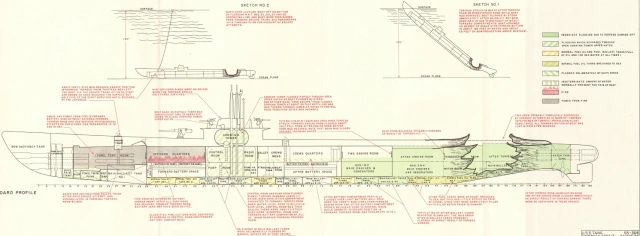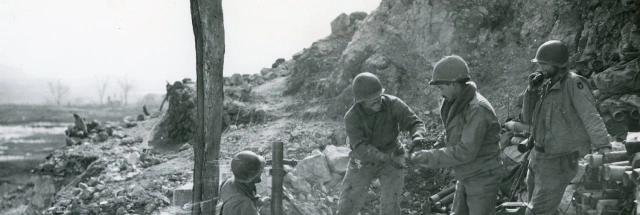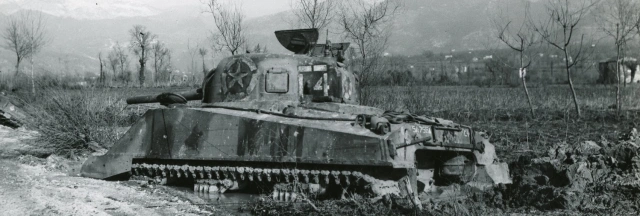| Hometown | Civilian Occupation |
| Wilmington, Delaware | Welder |
| Branch | Service Number |
| U.S. Army | 32488779 |
| Theater | Unit |
| European | Company “M,” 320th Infantry Regiment, 35th Infantry Division |
| Military Occupational Specialty | Campaigns/Battles |
| 605 (machine gunner) | Normandy, Northern France, and Rhineland campaigns |
Author’s note: This article incorporates some text from my previous article about Private 1st Class Dallas I. Bowden, another member of the 35th Infantry Division who fought at Mortain.
Early Life & Family
Joseph Aloysius McGrath was born at 903 Lovering Avenue in Wilmington, Delaware, on October 4, 1911. He was the seventh child of John Joseph McGrath (1875–1946) and Ella McGrath (née Ella Agnes Brady, 1876–1952). His father worked in a Morocco leather factory, a major Wilmington industry in that era. McGrath had four older sisters, two older brothers (one of whom was stillborn or died very young), and one younger sister. Another younger sister was stillborn in 1917.
Journal-Every Evening reported that McGrath “attended St. Elizabeth’s Parochial School and Wilmington High School.” His enlistment data card recorded that McGrath had completed two years of high school, though the 1940 census stated that he had only completed the 8th grade.
McGrath was living with his family when he was recorded on the census on January 7, 1920, living at 1311 Chestnut Street in Wilmington. McGrath was recorded on the next census on April 14, 1930, living with his family at 607 Maryland Avenue in Wilmington. His occupation was listed as woodworker apprentice for a contractor. His family had moved again by the time of the next census, taken on April 11, 1940, which recorded them at 1105 Read Street in Wilmington. McGrath’s occupation was listed as pipe fitter.
McGrath worked as a welder before entering the service. When he registered for the draft on October 16, 1940, McGrath was living at 1105 Read Street and working for the Dravo Corporation. The registrar described him as standing approximately five feet, seven inches tall and weighing 155 lbs., with brown hair and blue eyes. An annotation on his draft card indicated that he had moved to 119 North Clayton Street in Wilmington prior to entering the service. McGrath was Catholic.
McGrath married Ellen Irene Moore (1917–2004) at her sister and brother-in-law’s home on Terminal Avenue in Eden Park Gardens, south of Wilmington, on May 9, 1942. Their marriage announcement in the Wilmington Morning News stated that the couple would be living at 1317 West 3rd Street in Wilmington. However, in his wife’s statement for the Delaware Public Archives, she listed his pre-service address as 515 (North) Jefferson Street in Wilmington.

Military Training
After McGrath was drafted, he joined the U.S. Army in Camden, New Jersey, on January 23, 1943. His wife’s statement indicates that he went on active duty at Fort Dix, New Jersey, on January 30, 1943. She wrote that he was initially stationed at San Luis Obispo, California, from February to April 1943. There, he most likely joined the 320th Infantry Regiment of the 35th Infantry Division.

The 320th Infantry had been activated at Camp San Luis Obispo in January 1943 and arrived at Camp Rucker, Alabama, in April 1943. The regiment participated in maneuvers in Tennessee beginning in November 1943 and was stationed at Camp Butner, North Carolina, from the end of January 1944 until early May 1944. Indeed, McGrath’s wife added that her husband was stationed at Camp Rucker from April 1943 through November 1943 and that following maneuvers in Tennessee, he was at Camp Butner, North Carolina, from January to May 1944. She wrote that he shipped out from Hoboken, New Jersey, aboard the Edmund B. Alexander on May 12, 1944, arriving at Liverpool, England, two weeks later.
When he went overseas, McGrath’s wife was pregnant with a son he would never get to meet, Joseph Ronald McGrath (also known as Ronald Joseph McGrath, 1944–1981). She gave birth on June 20, 1944, about three weeks before her husband went into combat.
By July 1, 1944, McGrath had been promoted to private 1st class and was a member of Company “M,” 320th Infantry Regiment. Company “M” was 3rd Battalion’s heavy weapons company.
A morning report listed McGrath’s Military Occupational Specialty (M.O.S.) as 605, machine gunner. Based on the tables of organization, he would either have been a machine gunner or an assistant machine gunner. Circumstantial evidence suggests he entered combat as a machine gunner and by late September 1944, he was acting as a squad leader. Each seven-man squad had a squad leader, machine gunner, assistant gunner, and four ammunition bearers.
At the time, each U.S. Army infantry battalion had three rifle companies, a heavy weapons company, and a headquarters company. Heavy weapons companies like McGrath’s had a total of eight M1917A1 Browning .30 heavy machine guns. Each squad had one machine gun. (There were two squads per section, two sections per platoon, and two machine gun platoons in the company.) Together with the weapons company’s mortar platoon, the machine gunners would provide supporting fire for the rifle companies.
Combat in France
On the afternoon of July 4, 1944, Company “M” of the 320th Infantry shipped out from England for Normandy, disembarking on July 7. In the month since D-Day, Allied forces had secured the beachhead but were struggling to break through the well-fortified German defenders.
Company “M” entered combat in the bocage west of La Ballolière on July 10, 1944, as part of an overall advance south to the vital crossroads at Saint-Lô. The enemy had to be rooted out hedgerow by hedgerow and the regiment initially made little progress. McGrath’s company suffered its first combat fatality on July 12 when Staff Sergeant Emil F. Koziol (1915–1944) was killed in action. Company “M” came out of the line on July 18, 1944.

After a brief rest as the Battle of Saint-Lô drew to a close, they returned to defensive positions prior to the start of Operation Cobra on July 25. Massive carpet bombing by Allied aircraft preceded an advance that finally broke the German lines in Normandy wide open. The 320th Infantry began a new advance to the southeast of Saint-Lô on July 27. Progress was rapid and the regiment took Torigni-sur-Vire on July 31, 1944. The regiment continued its advance, crossing the river Vire on August 2.
On the night of August 6–7, 1944, the Germans launched a counterattack with the objective of retaking Avranches, thereby splitting the U.S. First and Third Armies and shoring up the increasingly untenable German situation in Normandy. American resistance was fierce. The German attack made some headway against the 30th Infantry Division at Mortain, overrunning the town and encircling a battalion of the 120th Infantry Regiment on Montjoie (Hill 314).
In response to the German counterattack, on August 7, 1944, the 35th Infantry Division moved to the Mortain area. The 320th Infantry was initially in reserve as the rest of the division struck the German salient but joined the battle on August 9. Finally, on August 12, 1944, the 35th Infantry Division broke through to link up with the surviving defenders on Hill 314. The German counterattack had failed.

Private 1st Class McGrath was awarded the Combat Infantryman Badge per General Order No. 9, Headquarters 320th Infantry, dated August 20, 1944.
The Allied breakout from Normandy, combined with the Operation Dragoon landings in the South of France turned the German retreat into a rout. Some 60,000 enemy soldiers were killed or captured in the Falaise pocket and Paris was liberated on August 25, 1944. The 35th Infantry Division joined the pursuit, traveling by truck to Lorraine in northeast France. Euphoria gave way to frustration as the Germans consolidated their positions closer to their home territory and the Allies reached the limits of their supply lines, which stretched all the way back to Normandy. Private 1st Class McGrath’s battalion crossed the river Moselle on September 13, 1944. The U.S. Third Army soon had no choice but to assume a defensive posture due to a lack of fuel.
Unaware of the American supply issues, the Germans launched a counterattack, resulting in the Battle of Arracourt. During the battle, on September 19, 1944, the 320th Infantry was temporarily attached to the 4th Armored Division. On September 20, the 320th took up positions near Réchicourt-la-Petite and Juvrecourt, both in the department of Meurthe-et-Moselle, France. The next few days were static and the 320th Infantry had limited involvement in the battle, but the Germans subjected McGrath’s regiment to artillery fire and at least one small counterattack.
Private 1st Class McGrath was lightly wounded in action on September 23, 1944, but remained on duty. A digitized casualty card (also known as a hospital admission card) under his service number likely refers to the incident, notwithstanding its date of August 1944. The card stated that McGrath was grazed in the neck by a machine gun round.

On September 24, 1944, the 320th Infantry Regiment returned to the control of the 35th Infantry Division. Private 1st Class McGrath was reported as missing in action as of September 27, 1944, in the vicinity of Réchicourt-la-Petite. Authorities later determined that he had been killed on the date he went missing. In a letter to McGrath’s mother, the regimental assistant adjutant, Captain Gerard T. Armstrong wrote:
Joseph was acting squad leader in his platoon on the 27th of September. He was leading his men out of a defensive position which their company held near Rechicourt, France, when the enemy laid down a heavy artillery barrage on their positions. The unit was being replaced by an armored organization and when the transfer had been completed the company reorganized but Joseph could not be found.
Curiously, although the regimental after action report and morning reports are unclear, an official U.S. Army historian, Hugh M. Cole, wrote in his book, The Lorraine Campaign, that the 320th Infantry Regiment was relieved by the 4th Armored Division and went into reserve on September 26, 1944, not September 27. If so, Private 1st Class McGrath may have in fact been killed on September 26—especially if his body was indeed found at Réchicourt—though his official date of death remains September 27, 1944.


Captain Armstrong added in his letter:
Joseph was an excellent soldier at all times and exhibited such outstanding qualities of leadership that he was to have been promoted to the grade of sergeant on the very day that he disappeared. He was extremely well liked by all the officers and men of his unit.
The Wilmington Morning News reported on October 23, 1944, that Private 1st Class McGrath was missing, adding: “A mass was said in St. Peter’s Church yesterday for his safety and special prayers were said for the soldier in St. Elizabeth’s Church.”
On May 15, 1945, Journal-Every Evening confirmed that Private 1st Class McGrath had been killed on the date he went missing. Two days later, Captain Armstrong wrote to McGrath’s wife, stating: “Joseph was leading his squad out of a defensive position […] As they were moving out they encountered an enemy artillery barrage and Joseph was killed by an exploding shell.”
During his military career, McGrath earned the Purple Heart with one oak leaf cluster and the Combat Infantryman Badge.
Private 1st Class McGrath was initially buried as an unknown soldier at a temporary cemetery at Saint-Avold, France. After the war, his body was disinterred and identified. His mother requested that her son be interred in a permanent military cemetery overseas. Private 1st Class McGrath was reburied in a permanent cemetery at Neuville, Belgium, now known as the Ardennes American Cemetery (Plot C, Row 13, Grave 47). He is also honored at Veterans Memorial Park in New Castle, Delaware.
Ellen Irene McGrath remarried to Charles F. Fretz, Jr. (1915–2010) in Wilmington on June 8, 1946. The couple raised Private 1st Class McGrath’s son and two children of their own.
Notes
Date of Birth
Multiple documents establish McGrath’s date of birth as October 4, 1911, including his birth certificate, Wilmington birth register, his wife’s statement, and draft card. Curiously, the U.S. Army recorded his date of birth as October 4, 1912. I consider the 1911 date to be authoritative, especially given that the family has a copy of his birth certificate in which the attending physician and State Board of Health Bureau of Vital Statistics registrar both certified the birth as occurring in 1911.
Middle Name
The Wilmington birth register and his birth certificate recorded McGrath as Joseph McGrath with no middle name. His marriage certificate did not record middle names for either party. His draft card listed his middle name as Aloysius, and he served in the U.S. Army with the name Joseph A. McGrath.
Acknowledgments
Special thanks to the McGrath family for contributing photos and documents that were vital for telling Private 1st Class McGrath’s story. Thanks also go out to Special thanks to Roberta Russo (webmaster, 134th Infantry Regiment Website and historian, 35th Infantry Division Association) for the use of records and the Delaware Public Archives for the use of their photo.
Bibliography
Armstrong, Gerard T. Letter to Ella A. McGrath, April 17, 1945. Courtesy of the McGrath family.
Armstrong, Gerard T. Letter to Ellen M. McGrath, May 17, 1945. Courtesy of the McGrath family.
Byrne, B. A. “Action Against Enemy, Report After.” Headquarters 320th Infantry, August 4, 1944. World War II Operations Reports, 1940–48. Record Group 407, Records of the Adjutant General’s Office. National Archives at College Park, Maryland. 134th Infantry Regiment website. http://www.coulthart.com/134/320-aa-44-july.htm
Byrne, B. A. “Action Against Enemy, Report After.” Headquarters 320th Infantry, October 3, 1944. World War II Operations Reports, 1940–48. Record Group 407, Records of the Adjutant General’s Office. National Archives at College Park, Maryland. 134th Infantry Regiment website. http://www.coulthart.com/134/320-aa-44-sept.htm
Byrne, B. A. “Action Against Enemy, Report After.” Headquarters 320th Infantry, September 4, 1944. World War II Operations Reports, 1940–48. Record Group 407, Records of the Adjutant General’s Office. National Archives at College Park, Maryland. 134th Infantry Regiment website. http://www.coulthart.com/134/320-aa-44-aug.htm
“Charles F Fretz Jr, 95.” The Intelligencer, November 12, 2010.
Cole, Hugh M. United States Army in World War II European Theater of Operations: The Lorraine Campaign. Originally published in 1950, republished by the Center of Military History, United States Army, 1993. https://history.army.mil/html/books/007/7-6-1/CMH_Pub_7-6-1.pdf
Delaware Marriages. Bureau of Vital Statistics, Hall of Records, Dover, Delaware. https://www.familysearch.org/ark:/61903/3:1:S3HY-X3W5-RY, https://www.familysearch.org/ark:/61903/3:1:S3HT-6PY9-B3B
Fifteenth Census of the United States, 1930. Record Group 29, Records of the Bureau of the Census. National Archives at Washington, D.C. https://www.ancestry.com/imageviewer/collections/6224/images/4531892_00360
Fourteenth Census of the United States, 1920. Record Group 29, Records of the Bureau of the Census. National Archives at Washington, D.C. https://www.ancestry.com/imageviewer/collections/6061/images/4295771-00588
“General Order Number 9.” Headquarters 320th Infantry, August 20, 1944. World War II Operations Reports, 1940–48. Record Group 407, Records of the Adjutant General’s Office. National Archives at College Park, Maryland. 134th Infantry Regiment website. http://www.coulthart.com/134/go-320-ir/go-320-44-9.pdf
Headstone Inscription and Interment Records for U.S. Military Cemeteries on Foreign Soil, 1942–1949. Record Group 117, Records of the American Battle Monuments Commission, 1918–c. 1995. National Archives at Washington, D.C. https://www.ancestry.com/imageviewer/collections/9170/images/42861_1521003239_0891-01010
Joseph McGrath birth certificate. Courtesy of the McGrath family.
McGrath, Ellen. Joseph Aloysius McGrath Individual Military Service Record, January 20, 1946. Record Group 1325-003-053, Record of Delawareans Who Died in World War II. Delaware Public Archives, Dover, Delaware. https://cdm16397.contentdm.oclc.org/digital/collection/p15323coll6/id/19916/rec/1
Miskimon, Christopher. “Stubborn Defense at Rechicourt.” WWII History, June 2021. https://warfarehistorynetwork.com/article/stubborn-defense-at-rechicourt/
Morning reports for Company “M,” 320th Infantry Regiment. July 1944 – October 1944. U.S. Army Morning Reports, c. 1912–1946. Record Group 64, Records of the National Archives and Records Administration. National Personnel Records Center, St. Louis, Missouri. 134th Infantry Regiment website. http://www.coulthart.com/134/mr-320-m-company/mr-320-m-1944-9-23.pdf, http://www.coulthart.com/134/mr-320-m-company/mr-320-m-1944-10-1.pdf
“One of Four Sons Serving In Navy Hurt.” Journal-Every Evening, October 23, 1944. https://www.newspapers.com/clip/118152918/mcgrath-missing/
Silverman, Lowell. “Private 1st Class Dallas I. Bowden (1923–1944).” Delaware’s World War II Fallen website, October 9, 2022. Updated November 18, 2022. https://delawarewwiifallen.com/2022/10/09/private-1st-class-dallas-i-bowden/
Sixteenth Census of the United States, 1940. Record Group 29, Records of the Bureau of the Census. National Archives at Washington, D.C. https://www.ancestry.com/imageviewer/collections/2442/images/m-t0627-00552-00141
Stanton, Shelby L. World War II Order of Battle: An Encyclopedic Reference to U.S. Army Ground Forces from Battalion through Division 1939–1946. Revised ed. Stackpole Books, 2006.
“Table of Organization and Equipment No. 7-18: Infantry Heavy Weapons Company.” War Department, February 26, 1944. Military Research Service website. http://www.militaryresearch.org/7-18%2026Feb44.pdf
U.S. WWII Hospital Admission Card Files, 1942–1954. Record Group 112, Records of the Office of the Surgeon General (Army), 1775–1994. National Archives at College Park, Maryland. https://www.fold3.com/record/704804633/mcgrath-joseph-a-us-wwii-hospital-admission-card-files-1942-1954, https://www.fold3.com/record/704804634/mcgrath-joseph-a-us-wwii-hospital-admission-card-files-1942-1954
War Department letter to Ella A. McGrath, November 3, 1949. Courtesy of the McGrath family.
“W. W. Grier, Jr., Army Officer, Killed in Action.” Journal-Every Evening, May 15, 1945. https://www.newspapers.com/clip/118153191/mcgrath-kia/
“Weddings.” Wilmington Morning News, May 16, 1942. https://www.newspapers.com/clip/121204117/moore-mcgrath-wedding/
Wilmington Birth Register, 1909–1912. Record Group 1500.205. Delaware Public Archives, Dover, Delaware. https://www.familysearch.org/ark:/61903/3:1:33S7-LBC2-SK1
“Wilmington Man Listed as Missing.” Wilmington Morning News, October 23, 1944. https://www.newspapers.com/clip/118152101/joseph-mcgrath-mia/
World War II Army Enlistment Records. Record Group 64, Records of the National Archives and Records Administration. National Archives at College Park, Maryland. https://aad.archives.gov/aad/record-detail.jsp?dt=893&mtch=1&cat=all&tf=F&q=32488779&bc=&rpp=10&pg=1&rid=3099693
WWII Draft Registration Cards for Delaware, 10/16/1940–3/31/1947. Record Group 147, Records of the Selective Service System. National Archives at St. Louis, Missouri. https://www.ancestry.com/imageviewer/collections/2238/images/44003_06_00005-00679
Last updated on March 21, 2023
More stories of World War II fallen:
To have new profiles of fallen soldiers delivered to your inbox, please subscribe below.











